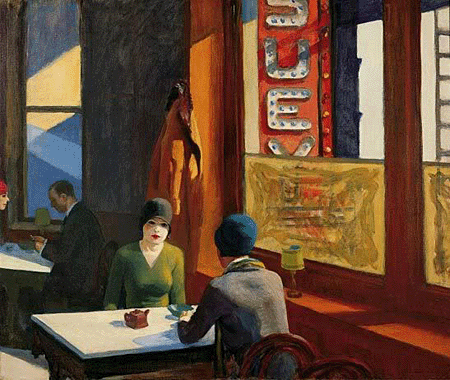
|
Chop Suey,
1929
Oil on canvas, 32" x
38"
Collection Mr. and Mrs. Barney
A. Ebsworth |
The window-panes in this >
Edward
Hopper painting seem to resemble the interfaces that
emphasize the interior of the restaurant. Geometrical color fields define the
window in the background. The window on the right side only allows a limited
view. Visible is a facade, a fire escape, a patch of sky and the neon sign of
the Chop Suey restaurant. Due to their art nouveau style-like head-gear and
their heavily made up faces, the women seem to have a doll-like and rigid
impression. This concerns the posture of the woman in the foreground, facing
the beholder, but is especially visible on the woman in the background, who
has even a more rigid impression. We see her face in profile, like she is a
figurehead. The man who is sitting at her table seems self-absorbed, his
facial expressions dissapear in the shadow.
The heavy made-up faces of the women also
suggest temptation. The billboard of the Chop Suey-restaurant reminiscents an
entertainment district, the powerful red of the board corresponds with the
accentuated mouths of the women and the half-covered letters of the word 'suey'
are easily associated with the word 'sex'. The symbols for temptation,
desolation and rigidity are directly linked; and just like almost any another
Edward Hopper painting, this canvas requires a double vision.
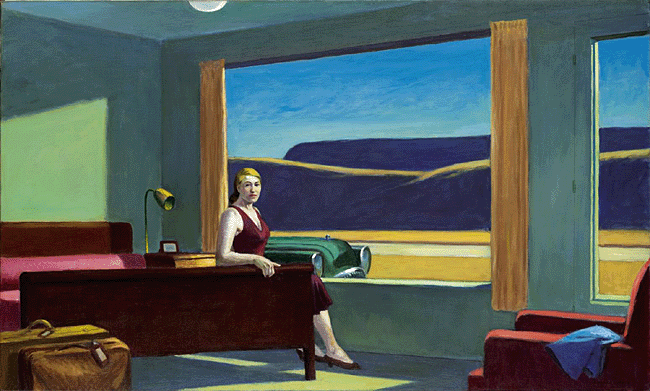 |
Western Motel, 1957
Oil on canvas, 30 1/4" x 50
1/10"
New Haven, Connecticut, The Yale
University Art Gallery
|
In this >
Edward
Hopper painting entitled Western Motel, the
unusually large windows in the composition extend a typical Western scenery.
The woman sitting on the bed is not watching the landscape, but in the
direction of the viewer. In the whole of the composition she resembles a
portrait for a background which seems to be fossilized into a painting. But
strangely enough this motel scene connects elements of rigidness and movement.
It is true that its signs, the car and street, due to the motionless posture
of the woman who is the centre of the painting, have lost their dynamics at
first sight. But as a reaction to this, the falling light into the room brings
the warm colors as much to life as the landscape, in front of the window,
fossilizes them.
While the interior suggests movement, the view
on the American landscape changes into a view on a scenery. It recalls a lost
domain, a vision on America in days gone by and to the memory of a direct
encounter of nature and civilisation. It is the far-reaching experience of the
technical civilisation in the New World.
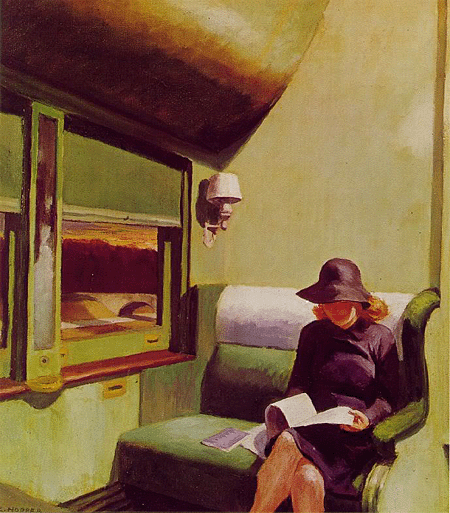
|
Compartment C, Car 193, 1938
Oil on Canvas, 20" x 18"
Armonk, New York
IBM Corporation collection
|
An Edward Hopper painting, that reverts to his
earlier designs and at the same time evokes a new effect and a certain
surprise on the beholder.On the one side, through the window of the coupé a
landscape is visible with the river, the bridge and the dark wood on the
horizon showing a boundary of the civilisation within the natural landscape.
On the other side, the painting gets his special dynamic through the oblique
perspective.
Compartment C also remains ambigous
because of its theme of enclosure, that takes place in relative peace. The
play of colors doesn't intersect the relations between inside and outside
completely, but creates contexts; the engrossed reading of the woman is
determined by peaceful relaxation and concentration.
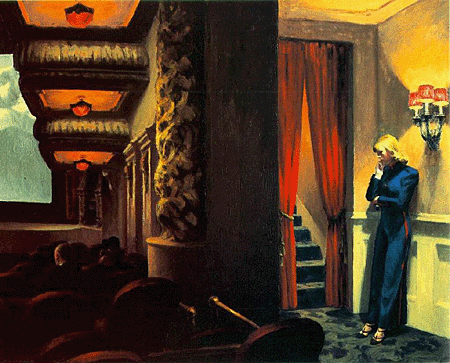
|
New York Movie, 1939
Oil on canvas, 32 1/4" x 40"
New York, collection of the Museum of Modern Art,
anonymous gift
|
The New York Movie-painting has a
parallel with the previous Edward Hopper painting Compartment C.
Instead of the view thorugh the window in Compartment C the focus here
is on a movie screen: together with the audience in the room the admirer of
the painting looks at a Alpine landscape. This sight determines only a part of
the painting; it is almost lost in the monumentality of the interior which is
divided in stage, gradually ceiling layered formations and lamps, columns,
curtains, corridor and stairs.
The usherette has the same deepened impression
of the train traveler in Compartment C. But apparently this woman is
neither interested in the view nor the illusion of the cinema.
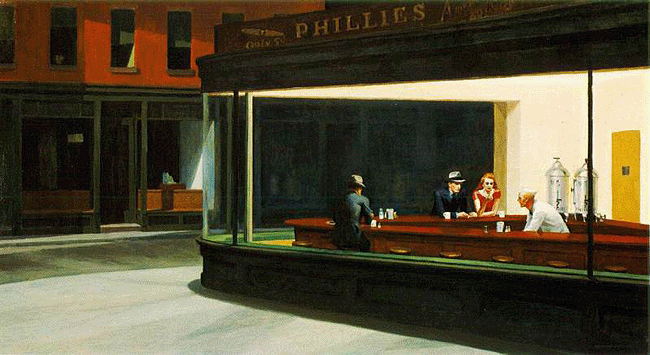
|
>
Nighthawks
1942
Oil on canvas, 30" x 56 3/4"
The Art Institute of Chicago
|
This late and most famous Edward Hopper
painting is his only painting that depicts convex glass and makes the glass
visible: the space of the bar surrounds the people like a hermetically sealed
container. Besides we see a separation of both the urban environment as
nature. The night in town is only illuminated by the light in the bar. Because
the light enters obliquely, the composition obtains a suggestive dynamic, in
which the light becomes the centre of the painting.
Although Hopper points out that he unconciously
had painted "the loneliness of the big city", at the same time he
emphasized the simplicity of the painting, in which he only tried to depict
"a restaurant at Greenwich Avenue", where two streets come together.
The canvas is characterized by a psychological tension. To the desolation in
the cities and the loneliness of the third bar visitor, the gathering of the
couple is added, and on that, the psychological effect is based. Although this
Edward Hopper painting emphasizes, by contrasting the bar and the shop
in the background, the social environment, it is above all things a projection
plane for various fantasies.
"Hopper is just a bad painter. But if
he had been a better painter, he probably would not have been such a great
artist".
-- Clement Greenberg (art critic)
Click here for more articles on American Art: >
Lowbrow
art and >
Outsider
Folk Art